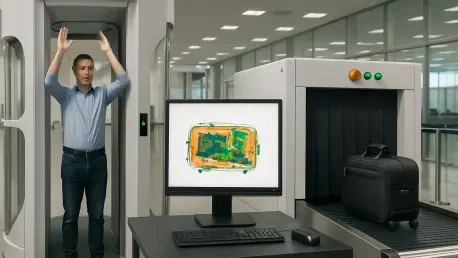In an era where global air travel handles millions of passengers daily, the challenge of maintaining robust security without sacrificing efficiency has never been more pressing, especially as airports face the daunting task of screening vast numbers of travelers and luggage while ensuring safety and minimizing delays. Advanced security technologies, such as cutting-edge CT scanners and biometric systems, have emerged as game-changers in this high-stakes environment. These innovations promise to revolutionize the way airports operate, balancing stringent safety measures with the growing demand for seamless travel experiences.
The aviation industry stands at a critical juncture, with passenger volumes soaring—evidenced by a 5% increase in traffic at major hubs like Munich Airport in the current year. This surge underscores the urgency for smarter, faster, and more reliable security solutions. As threats evolve, so must the tools designed to counter them, making the adoption of advanced tech not just beneficial but essential for modern airports.
Diving into Core Security Technologies
CT Scanners: Redefining Threat Detection
At the heart of modern airport security lies the transformative power of CT scanners, which provide detailed 3D imaging for unparalleled accuracy in identifying potential threats. Unlike traditional X-ray systems, these scanners allow for a comprehensive view of bag contents, reducing the need for manual checks and enabling passengers to keep liquids and electronics in their carry-ons. This technology significantly enhances detection capabilities, catching even the most concealed items with precision.
Performance metrics highlight the impact of CT scanners on operational efficiency. At Munich Airport, where these systems have been fully integrated into Terminals 1 and 2 since earlier this year, an impressive 95% of passengers clear security in under 10 minutes, with 90% doing so in under 5 minutes. Such statistics demonstrate how this technology streamlines processes, cutting wait times and improving throughput at busy checkpoints.
Beyond speed, CT scanners contribute to a safer travel environment by minimizing human error in threat detection. Their ability to rotate and analyze objects from multiple angles ensures that security personnel can focus on genuine risks rather than false positives. This reliability positions CT scanners as a cornerstone of advanced airport security frameworks.
Biometric and AI-Driven Innovations
Complementing CT scanners are biometric technologies like facial recognition and fingerprint scanning, paired with AI algorithms for real-time threat assessment and passenger verification. These systems expedite identity checks by matching travelers against secure databases, often eliminating the need for physical documents at multiple points. The result is a smoother journey from check-in to boarding, with reduced friction for passengers.
AI plays a pivotal role in enhancing the accuracy of these biometric solutions, analyzing patterns and behaviors to flag anomalies before they escalate. By automating routine tasks, such systems allow security staff to concentrate on complex issues, thereby decreasing the likelihood of oversight. This synergy of biometrics and AI is redefining precision in airport security protocols.
The significance of these tools extends to building trust among travelers, as they offer a contactless and efficient alternative to traditional methods. With privacy safeguards in place, such technologies are gaining traction as indispensable components of modern security ecosystems, ensuring both safety and convenience remain top priorities.
Cutting-Edge Developments in Security Tech
Next-Generation Screening Tools
Recent advancements in airport security technology include the rollout of next-generation CT scanners with even sharper imaging capabilities and faster processing speeds. These upgraded systems are designed to handle higher passenger volumes without compromising on detail, addressing the needs of high-traffic hubs. Their integration marks a significant step toward fully automated screening processes in the near future.
Additionally, AI-driven predictive analytics are emerging as powerful tools for identifying potential risks before they materialize. By analyzing vast datasets, including passenger behavior and historical threat patterns, these systems enable proactive measures, enhancing preparedness at security checkpoints. Such innovations reflect a shift toward anticipatory rather than reactive security strategies.
Contactless and Automated Trends
A notable trend shaping airport operations is the move toward contactless processes, driven by biometric tech and automated security lanes. These solutions minimize physical interactions, a priority for health and efficiency in today’s travel landscape. Passengers can now navigate checkpoints with minimal staff intervention, reducing bottlenecks during peak hours.
Automated lanes, equipped with self-service kiosks and integrated scanning systems, further optimize the flow of travelers. Major airports are increasingly adopting these setups to handle growing demand, ensuring that security remains robust without becoming a barrier to smooth operations. This trend signals a future where convenience and safety are seamlessly aligned.
The push for automation also extends to baggage handling, where AI systems track and screen luggage with minimal human input. As these technologies mature, they promise to redefine airport workflows, setting new benchmarks for operational excellence in the aviation sector over the coming years.
Real-World Impact at Leading Airports
Case Study: Munich Airport’s Tech Deployment
Examining real-world applications, Munich Airport stands out as a leader in adopting advanced security tech. Since early this year, the airport has equipped its central screening areas in Terminals 1 and 2 with state-of-the-art CT scanners, resulting in dramatically reduced wait times. This deployment has set a high standard, with the majority of passengers experiencing swift and hassle-free security checks.
Beyond wait times, Munich Airport’s focus on technology has bolstered its operational efficiency amid a 5% rise in passenger and flight traffic. The airport’s on-time performance has improved to over 75%, placing it among the top three European hubs for punctuality despite challenges like adverse weather and airspace restrictions. Such outcomes highlight the tangible benefits of tech integration.
The broader impact includes enhanced passenger satisfaction, as travelers benefit from a streamlined experience without compromising safety. Munich’s success serves as a model for other airports, demonstrating how targeted investments in security tech can yield significant returns in both performance and reputation.
Industry-Wide Implications
Across the aviation industry, advanced security technologies are driving a paradigm shift in how airports balance safety with efficiency. High-traffic hubs, in particular, are seeing improved throughput and reduced delays, which directly translate to better customer experiences. This is especially critical as intercontinental travel demand grows, with an 8% surge noted at key European airports.
Moreover, these technologies are strengthening global aviation standards by providing consistent and reliable threat detection. Airports adopting such systems are better equipped to handle evolving risks, fostering confidence among stakeholders. The ripple effect is evident in the push for standardized tech adoption across regions to maintain competitive edges.
Unique use cases, such as integrating security tech with expanded route networks, further illustrate the versatility of these solutions. As airports like Munich connect to over 200 destinations worldwide, advanced systems ensure that increased connectivity does not come at the expense of safety, reinforcing their role as vital industry assets.
Navigating Challenges in Tech Adoption
Technical and Financial Barriers
Despite their benefits, implementing advanced security technologies comes with significant challenges, including high costs and complex integration with existing infrastructure. Upgrading to CT scanners and biometric systems often requires substantial capital investment, which can strain budgets, especially for smaller airports with limited resources. This financial hurdle remains a key obstacle to widespread adoption.
Technical difficulties also arise when aligning new systems with legacy equipment, often necessitating extensive overhauls of current setups. Downtime during installation can disrupt operations, posing logistical issues for busy hubs. Addressing these integration challenges requires careful planning and phased rollouts to minimize impact on daily activities.
Privacy and Regulatory Concerns
Another critical issue is the privacy concern surrounding biometric data collection, as passengers and advocacy groups question how such information is stored and used. Ensuring robust data protection measures is paramount to maintaining public trust, as any breach could undermine confidence in these technologies. Airports must navigate a delicate balance between security needs and individual rights.
Regulatory hurdles further complicate deployment, with varying standards across countries creating compliance challenges for international hubs. Harmonizing these regulations is an ongoing effort, as is addressing public perception through transparent communication about data handling practices. Overcoming these barriers is essential for broader acceptance of advanced security tools.
Efforts to mitigate these limitations include developing scalable solutions that cater to diverse airport sizes and budgets. Collaborative initiatives between governments, tech providers, and airport authorities are also underway to establish unified guidelines, ensuring that innovation progresses without compromising ethical or legal standards.
Envisioning the Future of Airport Security
Toward Fully Automated Checkpoints
Looking ahead, the trajectory of airport security technology points toward fully automated checkpoints that require minimal human oversight. Such systems would leverage advanced AI and robotics to handle everything from passenger screening to baggage checks, drastically reducing wait times. This vision, though ambitious, is within reach as current innovations continue to evolve.
Sophisticated AI systems are also expected to enhance predictive security, identifying threats with even greater accuracy by analyzing real-time data streams. These advancements could transform airports into proactive environments where risks are addressed before they emerge. The potential for such tech to redefine safety protocols is immense, promising a new era of travel security.
Long-Term Impact on Aviation
Over the long term, these technologies are poised to reshape airport operations by fostering greater passenger trust through reliable and transparent processes. As automation becomes standard, airports could see a reduction in operational costs, allowing for reinvestment in other areas like infrastructure or customer service. This shift would elevate the overall travel experience.
Global aviation standards are likely to evolve in tandem, with advanced tech setting benchmarks for safety and efficiency worldwide. The emphasis will remain on balancing security with convenience, ensuring that innovation serves both travelers and industry stakeholders. Airports that adapt early to these trends will likely lead the way in setting future norms.
Reflecting on the Journey of Security Tech
Looking back, the integration of advanced security technologies like CT scanners and biometrics marked a turning point for the aviation industry, delivering unprecedented efficiency and safety. Their deployment at leading hubs demonstrated measurable improvements, from slashing wait times to enhancing threat detection, setting a precedent for operational excellence. The journey revealed both the transformative potential and the complexities of adopting cutting-edge solutions.
As the industry moves forward, the focus should shift to addressing lingering challenges, particularly around cost and privacy, through collaborative frameworks and scalable innovations. Airports must prioritize transparent communication to build traveler confidence while investing in research for next-gen tools. These steps will ensure that security tech continues to evolve, safeguarding air travel for years to come.









